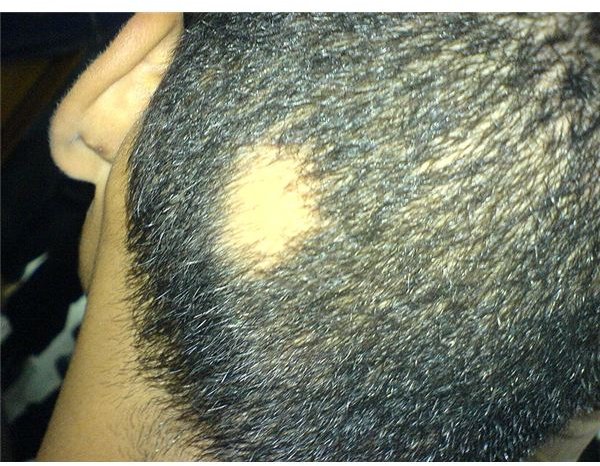What is Alopecia Areata and How are Genes Involved in Alopecia Areata Causes
Introduction
What is alopecia areata? Well, technically, it is a pathological condition characterized mainly by the loss of hair in a clearly delimited area. While the most common and clearly visible area affected by alopecia areata is the scalp, the loss of hair that characterizes this condition can affect any part of the body that exhibits hair growth.
Under normal conditions, hair follicles go through certain well-defined stages during their life cycles. The two phases that are of interest to us when discussing alopecia areata are the catagen and telogen stages. The former stage is the stage at which the growth of hair follicles stops, while it is during the latter stage that hair follicles actually fall out of the area of the body from which they were growing. Normally, a few random hair follicles enter the catagen and telogen stages, but since other hair follicles keep growing normally, the effects of the loss of a small number of follicles are not noticeable. In alopecia areata, all the hair follicles of a well-defined area enter the catagen and telogen stages and so fall out all at the same time. This is why hair loss becomes very noticeable.
Alopecia Areata Causes
So the next question is: what causes all the hair follicles to enter the catagen and telogen stages? The answer regarding alopecia areata causes is not so clear at the moment. Studies have shown that something like emotional stress can actually be a very good candidate for the cause of alopecia areata. Besides stress, though, a significant role in causing the disease is played by genetic factors. Indeed, the condition seems to run in families, giving a strong indication that genes are somehow responsible. Just how responsible, though, is not extremely clear.
First of all, alopecia areata is a polygenic dominant disease with partial penetrance. What those fancy terms mean, essentially, is that whether or not an individual would be likely to develop alopecia areata does not depend on the presence of a single gene, but on the presence of several genes. However, the simple presence of these genes really only accounts for making individuals susceptible to developing alopecia areata. The genes do not seem to be the immediate and direct cause of the onset of the condition, which is believed to environmental. An interesting point to this effect is that in studies of identical twins, who have the same genetic makeup, it has been shown that if one of the twins is affected with alopecia areata, there is only a 55% chance that the other twin will develop the condition, despite the fact that he or she possesses all the genes that determine susceptibility.
Because the presence of these “susceptibility genes” does not necessarily lead to full blown alopecia areata, many people possessing these genes can simply be “carriers”, without showing signs of the condition. However, the more susceptibility genes are present, the more likely it will be for the condition to be triggered by some environmental factor. Also, the more susceptibility genes present, the wider the area that will be affected and the more persistent the disease. The specific characteristics of the condition, including the affected surface area and resistance to treatment, strongly depends on the interaction of these susceptibility genes.
Is Alopecia Areata an Autoimmune Disorder?
According to genetic analyses performed on patients suffering from alopecia areata, the genes that are the most likely to be the ones on which the susceptibility, the severity and the resistance of the condition depend are the HLA-D genes. The Human Leukocyte Antigen genes, or HLA genes, are genes that are found on chromosome 6; these genes code for the major histocompatibility complex, or MHC, proteins. These proteins play an important role in presenting antigens to cells of the immune system, thereby triggering an immune response.
Normally, immune cells called lymphocytes are stimulated to attack “foreign” cells when they are presented with foreign antigens bound to MHC proteins. Lymphocytes will attack cells that possess these foreign antigens wherever and whenever they find them throughout the body. In the case of alopecia areata, it seems as if the lymphocytes are confused by the MHC proteins, which may be faulty due to genetic defects, and attack cells of the body, believing them to be foreign; a condition in which the immune system attacks the cells of its own body is called an “autoimmune” condition.
Biopsies performed on samples of skin from areas affected by alopecia areata have shown that immune cells are present inside hair follicles, while under normal conditions these cells are absent. Some researchers have hypothesized that in individuals affected by alopecia areata, some hair follicle antigen is presented to lymphocytes by potentially faulty MHC proteins and this provokes the lymphocytes into attacking hair follicles, causing their death and loss, and triggering the condition.
Conclusion
Even though there is no strict correlation between the presence of certain genes and the onset of alopecia areata, the HLA genes that have been identified are markers of susceptibility for this condition and need to be researched further. These genes can indeed be used to develop screening assays that could potentially be used by dermatologists to identify those individuals that have a higher probability of developing alopecia areata. Individuals at higher risk for the condition could be warned in advance about their susceptibility, allowing them to try to avoid any potential trigger factors that could lead to the onset of alopecia areata.
Picture Credit
Released into the public domain by Abbassyma
